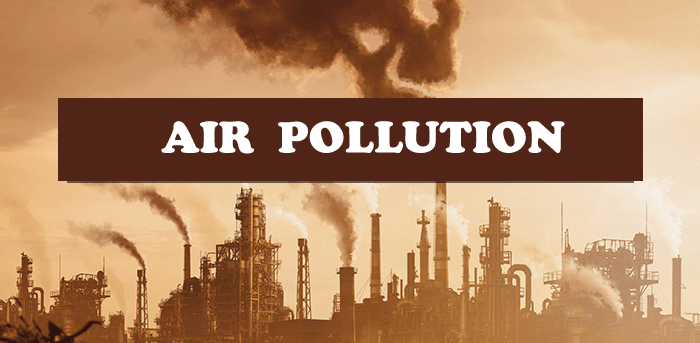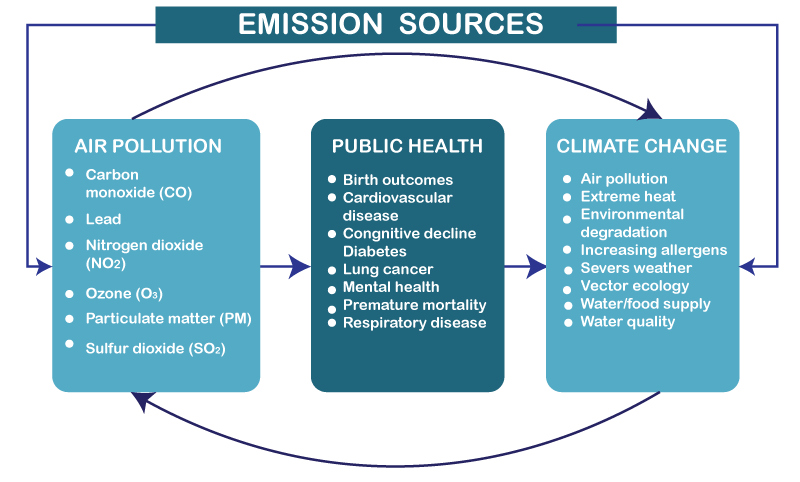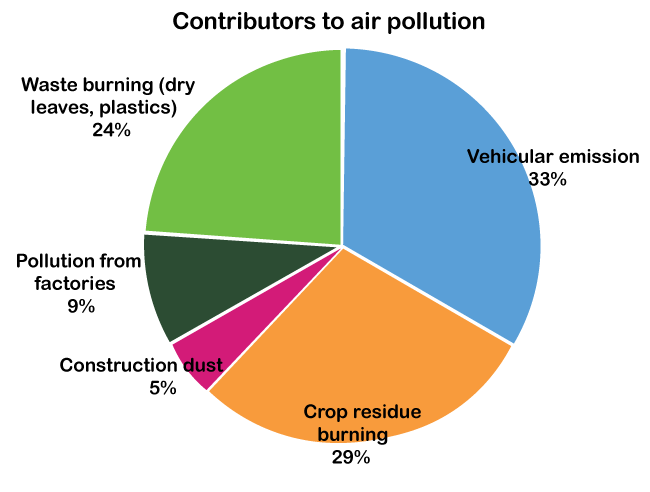Air Pollution Definition
What is Air Pollution?
Air pollution describes the occurrence of substances in the atmosphere that are harmful to the health of people and other living things or that impact the environment or materials. These substances can exist as gases, particles, or biological molecules. Numerous natural and artificial factors lead to air pollution, and forest fires, volcanic eruptions, and dust storms are natural causes. Examples of human-made sources are power plants, manufacturing, transportation, agriculture, and waste disposal.

Respiratory issues, heart disease, and cancer are just a few of the harmful consequences that air pollution may have on people's health. Additionally, it can damage crops, kill animals, and worsen climate change.
There are several types of air pollution, including:
- Tiny particles suspended in the air make up particulate matter (PM) pollution. These particles can be inhaled and harm the heart and lungs.
- Ground-level ozone pollution: Ground-Level ozone is created when sunlight reacts with vehicle emissions and other sources. Pollution of this kind can harm plants and result in respiratory issues in humans.
- Carbon monoxide pollution: Carbon monoxide is a colorless, odorless gas that, in high amounts, can make people feel dizzy and headachey.
- Sulfur dioxide pollution: Sulfur dioxide is a strong gas that can harm the Lungs and also could contribute to acid rain.
- Nitrogen oxide pollution: Nitrogen oxide is a type of gas that can affect breathing and contribute to forming fine particles and ground-level ozone.
- Lead pollution can damage children's nervous systems and interfere with their development.

It's also crucial to remember that air pollution is not only a regional issue but also a global one because it is not confined to a single region and may be easily dispersed by wind and ocean currents far from their origin. Therefore, nations must cooperate to battle air pollution and advance sustainable techniques to help lower emissions.
Impacts of Air Pollution
Air pollution has a wide range of negative impacts on human health, the environment, and the economy.
- Respiratory issues are among the most common health effects of air pollution that are most severe. Lung cancer, asthma, and chronic bronchitis can all be brought on by exposure to ozone and particulate matter. Additionally, air pollution can worsen pre-existing heart problems, increasing the risk of heart attacks and stroke. Additionally, studies have linked air pollution to children's cognitive decline and developmental issues. The World Health Organization (WHO) estimates that outdoor air pollution causes 7 million premature deaths annually across the globe.
- Animals and crops can suffer harm from air pollution. Sulfur dioxide and nitrogen oxide contamination, which results in acid rain, can harm forests and kill fish in lakes and rivers. Animals and crops can suffer harm from air pollution. Sulfur dioxide and nitrogen oxide contamination, which results in acid rain, can harm forests and kill fish in lakes and rivers.
- Carbon dioxide, methane, and other greenhouse gases are released by burning fossil fuels, a major contributor to air pollution. These gases trap heat in the atmosphere of the Earth and contribute to global warming. By raising the levels of greenhouse gases in the atmosphere, air pollution also Promotes climatic change.
- Additionally, air pollution can affect the economy. Healthcare expenses for diseases brought on by air pollution and lost productivity because of illness can be very expensive. Tourism can be harmed by air pollution, and it can also impact property values in the affected areas.
In conclusion, air pollution has various adverse effects on the economy, the environment, and human health. In addition to harming animals, destroying crops, and contributing to climate change, it can also cause cancer, heart disease, and respiratory issues.
Causes of Air Pollution
There are several both natural and artificial factors that contribute to air pollution. Among the principal contributors to air pollution are:
- Industrial emissions: Pollutants, including sulfur dioxide, nitrogen oxides, and Industries like power plants, factories, and refineries release Particulate matter into the air. These pollutants can significantly affect air quality, particularly in places with high industrial activity.
- Transportation: Pollutants, including carbon monoxide, nitrogen oxides, and particulates, are all released into the air by vehicles like cars, trucks, buses, and airplanes. It is especially true in cities, where overcrowded roads can result in significant air pollution.
- Agriculture: Pesticide, fertilizer use, and raising cattle are agricultural practices that can pollute the air. For instance, particulate matter and ground-level ozone can develop due to methane and ammonia emissions from fertilizers.
- Residential and commercial use of fossil fuels: Pollutants may also be released into the air by burning fossil fuels for electricity and heating. Burning wood, coal, and oil produces sulfur dioxide, nitrogen oxide, and particulate matter.
- Natural sources: Volcanic eruptions, dust storms, and forest fires are examples of natural sources of air pollution. Particulate matter and sulfur dioxide are two contaminants that can be released significantly during these occurrences.
- Waste disposal: Methane and other air pollutants may be released during garbage burning and open dumping.

The effects of air pollution on human health and the environment can be severe. Long-term exposure to polluted air can cause cancer, cardiovascular and respiratory disorders, and other conditions. In addition to harming crops, forests, and waterways, air pollution also contributes to global warming. To combat air pollution, people, groups, and governments can take action to reduce emissions from artificial sources. Some examples include promoting sustainable energy, enhancing the transportation system, and implementing stricter emissions laws for the industry. Additionally, efforts can be made to promote sustainable agricultural and waste management techniques and reduce waste.
Ways to reduce the Air Pollution
Several steps can be taken to reduce air pollution and improve air quality. They are:
- Reducing emissions from power plants: Burning fossil fuels for electricity is one of the main causes of air pollution. Governments can adopt stricter emissions laws, spend money on renewable energy sources like solar, wind, and hydropower, and promote energy efficiency to reduce emissions from power plants. These can be accomplished by implementing laws like the Clean Air Act and The National Ambient Air Quality Standards (NAAQS) determining acceptable airborne pollutants. Governments can also offer financial incentives, such as tax credits and rebates, to encourage firms and individuals to invest in renewable energy sources.
- Improving transportation: Another significant contributor to air pollution is transportation. Governments can invest in public transport and encourage using electric and hybrid vehicles to cut emissions from automobiles, trucks, buses, and airlines. They can also enhance the infrastructure for walking and bicycling to decrease the number of cars on the road. Governments can also fund the development of electric and hydrogen fuel cell vehicles and the construction of charging stations. Congestion fees and road tolls are other tactics that can discourage using private vehicles and promote public transportation.
- Regulating industrial emissions: Factories and refineries also release pollutants into the air. Governments can control these emissions by imposing fines for noncompliance and limiting the number of contaminants that may be discharged. Additionally, they can put cap and trade systems in place, in which businesses are given emission limits and can buy or sell the right to emit certain pollutants. It offers businesses a financial incentive to cut their emissions.
- Reducing waste: Pollutants may be released into the air through landfills and garbage burning. Governments can encourage recycling and composting and Invest in more complex waste management technologies like decomposition and anaerobic digestion to lower these emissions. These methods can reduce methane emissions, a strong greenhouse gas, by keeping organic waste out of landfills.
- Improving agricultural practices: Air pollution can also be caused by agricultural practices like raising livestock and using fertilizers and pesticides. It can be accomplished by restricting the use of pesticides and fertilizers and offering financial incentives to farmers who implement environmentally friendly techniques. Governments can encourage organic farming methods and other Sustainable agriculture practices like reducing chemical use.
- Encourage individuals, households, and organizations to adopt eco-friendly practices: By adopting eco-friendly behaviors like using energy-efficient appliances, limiting water consumption, and switching to renewable energy sources, individuals, families, and organizations may also help to reduce air pollution. Governments can promote sustainability by setting up programs and campaigns that educate and encourage residents to adopt these behaviors.
- Promoting the use of clean fuels: Governments can encourage using clean fuels like electricity, hydrogen, and biofuels in industry and transportation to reduce reliance on fossil fuels, which are a significant cause of air pollution. It can be accomplished by offering financial incentives to businesses and individuals to switch to clean fuels as well as by restricting the usage of these fuels.
Conclusion
Urban and rural areas are both negatively impacted by air pollution, although the sources and extent of the issue can differ drastically between cities and small towns. The primary causes of air pollution in cities are energy generation, industry, and transportation. Cars, buses, and trucks are major contributors to air pollution in urban areas, as they emit pollutants such as nitrogen oxides, particulate matter, and carbon monoxide. Industries release contaminants into the air, including power plants, manufacturing, and building. In cities, buildings and other structures can trap pollutants and produce heat that can worsen air pollution. Adversely, agricultural practices like using fertilizers and pesticides and burning crops and other organic particles are often the main causes of air pollution in villages. Villages might also have less strict rules and regulatory procedures to reduce air pollution. In general, air pollution levels in cities are much higher than those in rural areas. According to the world health organization, the average amount of particulate matter (PM2.5) in cities is nearly three times higher than in rural areas. It is because cities have larger population densities and more concentrated pollution sources. Cities and villages may experience different effects of air pollution. In cities, air pollution can increase the risk of lung cancer, stroke, and respiratory and cardiovascular health issues. Asthma and chronic obstructive lung disease are other health disorders that air pollution can worsen (COPD). Air pollution can also harm people's health in villages, especially those regularly exposed to agricultural activity-related pollutants.
Air pollution is a serious issue in urban and rural areas, but the sources and quantities can differ greatly across towns and cities. The effects of air pollution can also vary, with cities often suffering more serious health effects due to higher pollution levels. The specific causes and amounts of pollution in each location should be considered, along with any potential health effects, while making air pollution prevention efforts.
|



 For Videos Join Our Youtube Channel: Join Now
For Videos Join Our Youtube Channel: Join Now










